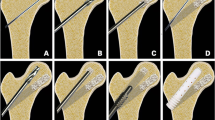Abstract
The osteonecrosis of the femoral head implies significant disability partly due to pain. After conventional core decompression using a 10-mm drill, patients normally are requested to be non-weight bearing for several weeks due to the risk of fracture. After core decompression using multiple small drillings, patients were allowed 50% weight bearing. The alternative of simultaneous implantation of a tantalum implant has the supposed advantage of unrestricted load bearing postoperatively. However, these recommendations are mainly based on clinical experience. The aim of this study was to perform a finite element analysis and confirm the results by clinical data after core decompression and after treatment using a tantalum implant. Postoperatively, the risk of fracture is lower after core decompression using multiple small drillings and after the implantation of a tantalum rod according to finite element analysis compared to core decompression of one 10-mm drill hole. According to the results of this study, a risk of fracture exists only during extreme loading. The long-term results reveal a superior performance for core decompression presumably due to the lack of complete bone ingrowth of the tantalum implant. In conclusion, core decompression using small drill holes seems to be superior compared to the tantalum implant and to conventional core decompression.





Similar content being viewed by others
References
Bergmann G, Graichen F, Rohlmann A (2004) Hip joint contact forces during stumbling. Langenbecks Arch Surg 389:53–59
Bobyn JD, Poggie RA, Krygier JJ, Lewallen DG, Hanssen AD, Lewis RJ, Unger AS, O’Keefe TJ, Christie MJ, Nasser S, Wood JE, Stulberg SD, Tanzer M (2004) Clinical validation of a structural porous tantalum biomaterial for adult reconstruction. J Bone Joint Surg Am 86-A(Suppl 2):123–129
Burstein AH, Reilly DT, Frankel VH (1973) Failure characteristics of bone and bone tissue. Perspect Biomed Eng 131–134
Camp JF, Colwell CW Jr (1986) Core decompression of the femoral head for osteonecrosis. J Bone Joint Surg Am 68:1313–1319
Dempster WT, Liddicoat RT (1952) Compact bone as a non-isotropic material. Am J Anat 91:331–362
Ficat RP (1985) Idiopathic bone necrosis of the femoral head. Early diagnosis and treatment. J Bone Joint Surg Br 67:3–9
Fischer KJ, Jacobs CR, Carter DR (1995) Computational method for determination of bone and joint loads using bone density distributions. J Biomech 28:1127–1135
Floerkemeier T, Thorey F, Daentzer D, Lerch M, Klages P, Windhagen H, von Lewinski G (2010) Clinical and radiological outcome of the treatment of osteonecrosis of the femoral head using the osteonecrosis intervention implant. Int Orthop. doi:10.1007/s00264-009-0940-9
Fung DA, Frey S, Menkowitz M, Mark A (2008) Subtrochanteric fracture in a patient with trabecular metal osteonecrosis intervention implant. Orthopedics 31:614
Gao YS, Zhang CQ (2010) Cytotherapy of osteonecrosis of the femoral head: a mini review. Int Orthop 34:779–782
Kerboul M, Thomine J, Postel M, Merle dR (1974) The conservative surgical treatment of idiopathic aseptic necrosis of the femoral head. J Bone Joint Surg Br 56:291–296
Lutz A, Nackenhorst U (2008) Computation of static-equivalent load sets for bone remodeling simulation. (GENERIC) Conference Proceeding, Sixth International Congress on Industrial Applied Mathematics (ICIAM07) and GAMM Annual Meeting. ETH Zürich, Switzerland
Mont MA, Jones LC, Einhorn TA, Hungerford DS, Reddi AH (1998) Osteonecrosis of the femoral head. Potential treatment with growth and differentiation factors. Clin Orthop Relat Res 355S:314–335
Mont MA, Ragland PS, Etienne G (2004) Core decompression of the femoral head for osteonecrosis using percutaneous multiple small-diameter drilling. Clin Orthop Relat Res 429:131–138
Nadeau M, Seguin C, Theodoropoulos JS, Harvey EJ (2007) Short term clinical outcome of a porous tantalum implant for the treatment of advanced osteonecrosis of the femoral head. Mcgill J Med 10:4–10
Sedlin ED, Hirsch C (1966) Factors affecting the determination of the physical properties of femoral cortical bone. Acta Orthop Scand 37:29–48
Shuler MS, Rooks MD, Roberson JR (2007) Porous tantalum implant in early osteonecrosis of the hip: preliminary report on operative, survival, and outcomes results. J Arthroplasty 22:26–31
Smith SW, Fehring TK, Griffin WL, Beaver WB (1995) Core decompression of the osteonecrotic femoral head. J Bone Joint Surg Am 77:674–680
Steinberg ME, Larcom PG, Strafford B, Hosick WB, Corces A, Bands RE, Hartman KE (2001) Core decompression with bone grafting for osteonecrosis of the femoral head. Clin Orthop Relat Res 386:71–78
Tooke SM, Nugent PJ, Bassett LW, Nottingham P, Mirra J, Jinnah R (1988) Results of core decompression for femoral head osteonecrosis. Clin Orthop Relat Res 228:99–104
Veillette CJ, Mehdian H, Schemitsch EH, McKee MD (2006) Survivorship analysis and radiographic outcome following tantalum rod insertion for osteonecrosis of the femoral head. J Bone Joint Surg Am 88(Suppl 3):48–55
von Mises R (1913) Mechanik der Festen Korper im plastisch deformablen Zustand. Göttin Nachr Math Phys 1:582–592
Wang BL, Sun W, Shi ZC, Zhang NF, Yue DB, Guo WS, Shi SH, Li ZR (2009) Treatment of nontraumatic osteonecrosis of the femoral head using bone impaction grafting through a femoral neck window. Int Orthop 34(5):635–639. doi:10.1007/s00264-009-0940-9
Wang CJ, Wang FS, Huang CC, Yang KD, Weng LH, Huang HY (2005) Treatment for osteonecrosis of the femoral head: comparison of extracorporeal shock waves with core decompression and bone-grafting. J Bone Joint Surg Am 87:2380–2387
Wirtz DC, Schiffers N, Pandorf T, Radermacher K, Weichert D, Forst R (2000) Critical evaluation of known bone material properties to realize anisotropic FE-simulation of the proximal femur. J Biomech 33:1325–1330
Author information
Authors and Affiliations
Corresponding author
Rights and permissions
About this article
Cite this article
Floerkemeier, T., Lutz, A., Nackenhorst, U. et al. Core decompression and osteonecrosis intervention rod in osteonecrosis of the femoral head: clinical outcome and finite element analysis. International Orthopaedics (SICOT) 35, 1461–1466 (2011). https://doi.org/10.1007/s00264-010-1138-x
Received:
Accepted:
Published:
Issue Date:
DOI: https://doi.org/10.1007/s00264-010-1138-x




